The word Atitlan means Ancestor. And the Maya word Polopó stands for the Amate a type of fruit tree.
Here the women wear blue and purple striped huipiles and dark blue, plain or striped cortes. Roughly 15 - 17 years ago the colors of the huipiles used to be red however the woman got together and decided the color was not feminine or beautiful enough and decided to change the colors to different shades of blues and purples. This color they say represents the colors of Lake Atitlan.
T The population of San Antonio Polopó is just over five thousand inhabitants. (2012)
The founder of Modern Day San-Antonio-Palopo is Sain Anthony of Padua.
The Catholic church here is one of the oldest in Central America. ( Built in the mid 15th century.)
Local Mayan dialect is Kaqchikel.
The Maya inhabited Lake Atitlan around 500 BC. San Antonio was among one of the first of several villages to become a settlement, the first two settlements were in Santiago Atitlan on the southern shore of Lake Atitlan and Solola. Solola is located facing north of the Lake, but Solola is located high on the mountain tops over Lake Atitlan.
Many hundreds of years ago San Antonio Palopo’s steep slopes were covered with large trees. Houses were constructed out of bamboo mixed with mud, the roofs were made of palm leaves brought from the Pacific coast. The houses had dirt floors light was provided by candles or wood fire from the wooden stove they used for cooking. There were no roads leading to San Antonio Palopo only footpaths, two popular routs were to Godinez or to Santa Catarina Palopo. Locals often carried loads on their back, some used donkeys or horses. Footpaths stretched like a maze throughout the town leading houses to each other. The air was clean, the ambiance was quiet. Inside their houses, there may be a shelf and a small table. Families would often sleep very close together in one room either on the floor with a type of straw mat or on simple wooden beds. Surrounding the houses was lush green vegetation, fruit tress and vegetables. Lake Atitlan provided a fresh source of drinking water as did a waterfall located near the center of town which come from some run off but also of fresh springs.
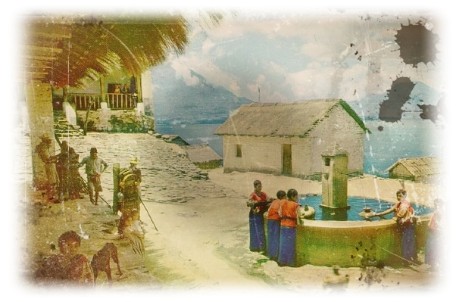 | In 2012 Most houses are made of cement blocks and have cement floors, electricity and running water. Houses are modest one or two room homes with very little inside as far as furniture. Plastic chairs and rustic wooden tables are common. Family members often live together in the same house but in separate rooms or close by in the same neighborhood. There are still houses that remain built by adobe walls, dirt floors and roofs made of thin corrugated metal. The majority of the village women use woodstoves to cook tortillas, beans and corn. This old tradition is slowly fading way for the use of cleaner and cheaper propane stoves.
|
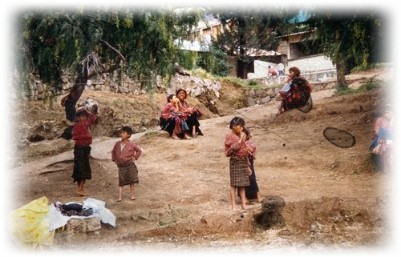 | 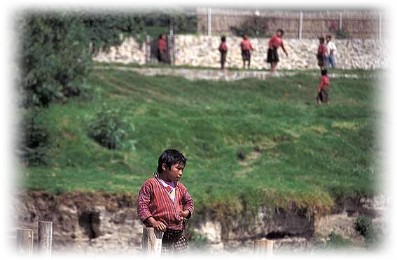 |
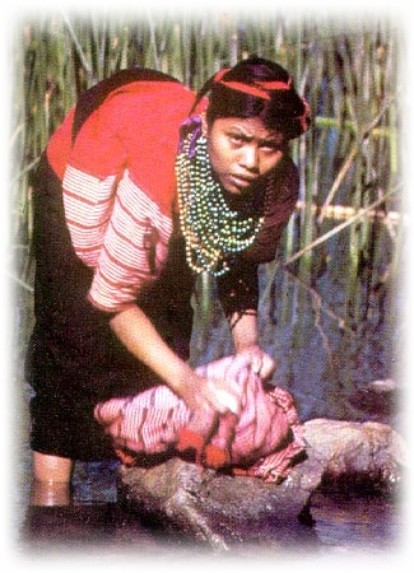 | Some Things Have Never Changed Yesteryear and today the women of San Antonio Palopo still prefer to do the laundry using rocks and water on the shores of Lake Atitlan Guatemala. While washers and dryers are now available in this village they are seldom used. Why would the women continue to wash their clothes on the lake shore rather than at home in a washer? There are several reasons why women prefer to continue this beautiful tradition. One of the reasons is that washing machines and dryers are very expensive, but this is not the majorities reason. While women of San Antonio have options of using different methods of washing clothes but the women enjoy doing laundry at the lakeside. This is their time to get out of the house, to enjoy the company of their friends who are also cleaning. They catch up on the latest gossip of the town. Sometimes they bring fishing line with them and catch a few fish while cleaning. Smiles are shared in the company of the other women in the town. Sometimes women also get very territorial... The lake's water level often raises and lowers depending on rainfall. This often leaves few perfect cleaning rocks left for the women to choose from. Finding a level rock to clean clothes on can sometimes be a difficult task. Every now and then women argue about who can use which rock for cleaning with. |
The women who come to wash clothes at the lake shore are usually accompanied by younger children. The children come to either help wash the clothes with the woman or to carry the washed clothes back up the mountain side to the woman's house. The children ( mostly girls) carry the washed laundry on top of their head with a large plastic basket. Laundry is normally done early in the morning for two reasons, the first reason being that the clothes will have all day to dry in the sun. The second reason is that at 10:30 strong winds come from the south and create waves on the shore which make washing difficult and dangerous. The dangers of washing clothes on the steep shoreline is that the majority of the women do not know how to swim. Sometimes women or children fall into the lake. Sometimes they drown. | 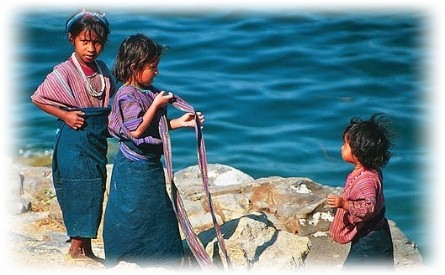 |